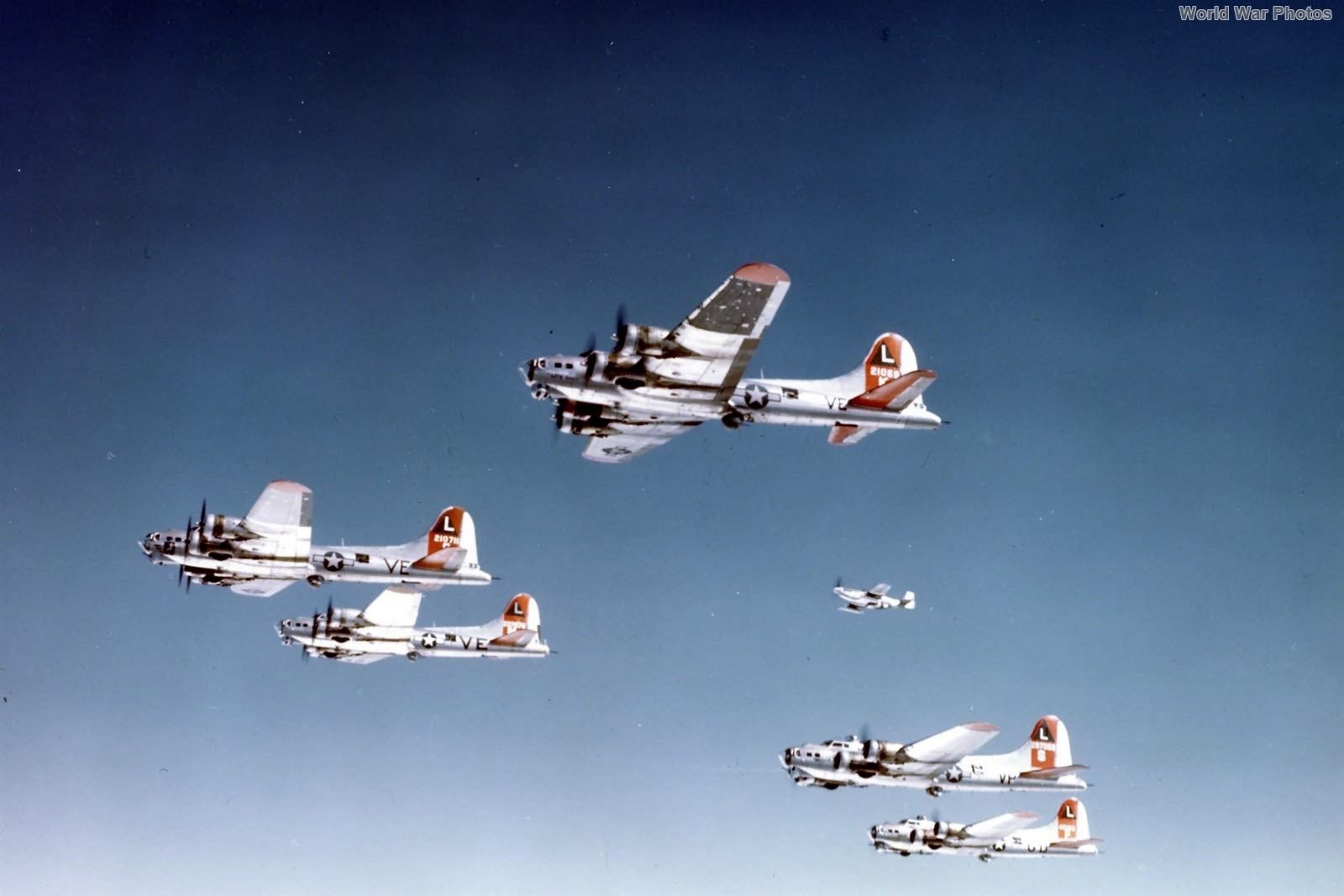381st Bombardment Group (H)
Overview:
- Assigned to Eighth Air Force (8th AF): May 1943
- Primary Aircraft: B-17F and B-17G Flying Fortresses.
- Component Squadrons: 532nd, 533rd, 534th, and 535th Bombardment Squadrons (H).
Wing & Command Assignments:
- VIII Bomber Command (BC), 1st Bombardment Wing (BW), 101st Provisional Combat Bombardment Wing (PCBW): June 1943
- VIII BC, 1st Bombardment Division (BD), 1st Combat Bombardment Wing (CBW): September 13, 1943
- 1st BD, 1st CBW: January 8, 1944
- 1st Air Division (AD), 1st CBW: January 1, 1945
Stations:
- Ridgewell: June 31, 1943 – June 24, 1945
- (Air echelon at Bovingdon: Late May 1943)
Group Commanding Officers:
- Col. Joseph J. Nazzaro: January 5, 1943 – January 9, 1944
- Col. Harry P. Leber Jr.: January 9, 1944 – February 6, 1945
- Lt. Col. Conway S. Hall: February 6, 1945 – June 1945
Combat Record:
- First Mission: June 22, 1943
- Last Mission: April 25, 1945
- Total Missions: 296
- Total Credit Sorties: 9,035
- Total Bomb Tonnage Dropped: 22,159.5 tons (including 24 tons of leaflets)
- Aircraft MIA (Missing in Action): 131
- Enemy Aircraft Claims: 223 destroyed, 40 probable, 162 damaged
Major Awards:
- Two Distinguished Unit Citations (DUC):
- October 8, 1943: Bremen mission
- January 11, 1944: (Awarded to all 1st Bombardment Division groups)
Claims to Fame:
- Suffered the highest losses of all groups during the first Schweinfurt mission (August 17, 1943).
Early History:
- Activated: November 3, 1942, at Gowen Field, Idaho.
- Training: Began at Pyote Army Air Base (AAB), Texas, on January 5, 1943. Final training was conducted at Pueblo, Colorado, from April 16, 1943, to May 8, 1943.
- Relocations:
- Ground Echelon: Moved to Camp Kilmer, New Jersey, arriving on May 12, 1943, and embarked on the Queen Elizabeth on May 21, 1943, arriving in Greenock on June 2, 1943.
- Air Echelon: Flew to Salina, Kansas, in early May 1943 and began movement to the UK on May 15, 1943, via Selfridge Field, Bangor, and Gander to Prestwick.
Subsequent History:
- Redeployed to the USA: May/June 1945. The majority of aircraft left the UK on May 24, 1945. The ground echelon sailed aboard the Queen Elizabeth on June 24, 1945, arriving in New York on June 29, 1945.
- Inactivation: The group was established at Camp Kilmer, with some personnel assembling at Sioux Falls Army Air Field, South Dakota, where the group was eventually inactivated on August 28, 1945.
Aircraft Markings and Identification:
- B-17F/G Fortresses (May 1943 – June 1945):
- Original combat B-17Fs were painted in Dark Olive Drab and Neutral Gray factory finishes.
- Squadron Code Letters:
- 532nd Bomb Squadron: VE
- 533rd Bomb Squadron: Initially OQ, later changed to VP
- 534th Bomb Squadron: Initially JZ, later changed to GD
- 535th Bomb Squadron: Initially PL, later changed to MS
- The call-letters of the 532nd and 534th Squadrons were from A onwards, including I, while the 533rd and 535th were from Z backward, with few exceptions.
- Markings Evolution:
- Initially, letters were in light gray (Sky) and 36 inches high, placed aft of the waist windows on both sides of the fuselage with individual aircraft call-letters forward of the cocarde.
- The introduction of the Triangle L Group marking in late June 1943 resulted in some changes:
- Call-letters were placed below the tail number and reduced to a height of 28 inches.
- Markings on bare metal B-17Gs (which began arriving in March 1944) included black squadron and call-letters with a white L on a black triangle.
- In late June 1944, red high-visibility markings were applied to tail surfaces and wing tips as per the 1st Combat Bomb Wing’s requirements.
- In May 1945, squadron and call-letters were painted under the left wing, 36 inches high, in black or yellow, depending on the contrast.
